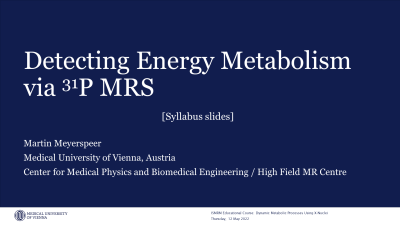Weekday Course
Detecting Dynamic Metabolic Processes Using X-Nuclei
Joint Annual Meeting ISMRM-ESMRMB & ISMRT 31st Annual Meeting • 07-12 May 2022 • London, UK

| X Nuclear I | |||
| 14:45 | Deuterium Metabolic Imaging & Thermal 13C MRS
Puneet Bagga
Imaging metabolic pathways by using non-invasive techniques has always been a challenge overcoming which may lead to opportunities for better diagnosis, planning a personalized treatment regimen, and evaluation of treatment response. Clinical translation of the multinuclear approaches combined with the administration of stable isotopes, such as 13C/2D labeled glucose, is yet to be widely utilized in clinical and preclinical studies. In this talk, I will discuss the development of 13C and 2D MRS techniques through the years and their potential future applications.
|
||
| 15:15 | Detecting Lung Function & Structure Using Hyperpolarized 129Xe
Jim Wild
Hyperpolarised 129Xe MRI offers a wealth of complementary information about the function and microstructure of the lungs, and in the dissolved phase, has potential for imaging perfusion and gas exchange in organs such as brain and kidneys. This talk will cover:Overview of polariser technology, RF , scanner platform and integration.Pulse sequence considerations for gas and dissolved phase xenon including the physical constraints posed by the hyperpolarised signal, T1/T2 , diffusion.Modelling of gas exchange and diffusion signal dynamics.Brief overview of clinical applications of 129Xe in lungs and other organs.
|
||
| X Nuclear II | |||
| 15:45 |  |
Detecting Energy Metabolism via 31P MRS
Martin Meyerspeer
Phosphorus-31 MRS can deliver quantitative metabolic information directly as peak intensities (reflecting metabolite concentration) or indirectly, via metabolic models. 31P sensitivity is high enough to acquire time series of thermal spectra, even localised, that reveal fluxes and rate constants of high-energy metabolites. Large 31P signal changes upon exercise make skeletal muscle a particularly interesting target for metabolic studies using dynamic 31P MRS. Other organs, like heart, liver or brain, can be investigated with magnetisation transfer or static 31P methods. 31P MRS information content can be further enriched by interleaved or simultaneous acquisition of 1H MRS or MRI data. |
|
| 16:15 | Sodium MRI
Guillaume Madelin
A review of sodium MRI: techniques, challenges and applications.
|
||
The International Society for Magnetic Resonance in Medicine is accredited by the Accreditation Council for Continuing Medical Education to provide continuing medical education for physicians.